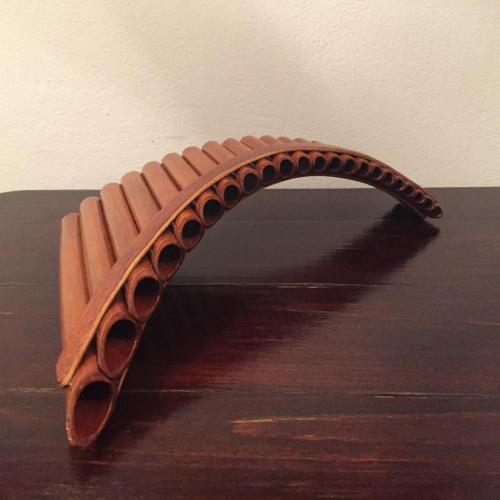Nai is an instrument with a bit of an identity crisis. The multitudinous contradictions it embodies in its search for a musical niche are what make it both such a fascinating subject of study and a somewhat frustrating one. So what exactly is this panpipe? Is it Romanian or foreign? Traditional or classical? High art or folk practice? Trying to answer these questions requires that one wade through tangled histories of peoples, governments, and economies. It also reveals the constructedness of these categories and the grey areas such distinctions fail to acknowledge. I will start in this post by sharing some of what I know about the instrument.
I first heard about the nai from a Peruvian ethnomusicologist while I was doing work in Lima. However, it is quite different from the Andean panpipes (antara and sikuri) that I studied there – it is curved and polished, and the bottom of each tube is plugged with either wax or a small wooden disk to allow for precise tuning. Today’s standard nai is diatonically tuned to G major and has 22 tubes, or three octaves. However, a musician can play in any key (or even alternate tuning systems) by tilting the instrument to alter the pitch. Professional-quality instruments can cost well over $1000.
The first point of contact I established for my project was the National University of Music, Bucharest (UNMB). As I met with an administrator there to arrange nai lessons, I asked whether the school had a folkloric orchestra that I might be able to participate in, or at the very least to observe. However, I was told rather dismissively that as a “scholarly” and “academic” institution, the UNMB has no such ensemble. The administrator was also unable to refer me to any external contacts. Somehow, panpipe has a place in this institution of “high art,” but the ensemble type that I had assumed was its habitat does not.
It became quite clear to me as soon as my lessons began that nai is treated quite differently from the other “folk” instruments I have studied in terms of pedagogy – in fact, these teaching techniques lead me to further question whether it can be called a folk instrument at all. For the first 4-6 weeks of my training, I was instructed to practice long tones, scales, arpeggios, vibrato, and various articulation techniques, all to the relentless beat of a metronome. This type of detail-oriented technical work is something I usually associate with classical music. When I encountered a student who is working toward her Bachelor’s at the UNMB, she explained to me that the panpipe students primarily study transcriptions of classical works originally for instruments like violin and clarinet.
After the UNMB, my next stop in the search for nai in a folk context was the Museum of the Romanian Peasant. However, neither of my contacts there could tell me very much about the instrument. From conversations with them, it dawned on me that there does not appear to be an active village musical tradition involving the panpipe in any part of the country. And even beyond that, a remark from one of them makes me question whether there ever really was one in the same sense as there was for fluier and caval, two other Romanian flutes. Unfortunately I don’t yet have enough information to confirm this suspicion, but hopefully I will be able to put together more pieces of the historical puzzle to share in a future post.
